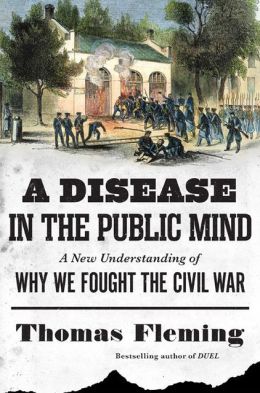
Illustration from 1911 Cosmopolitan article
As I’ve no doubt mentioned before, I’ve been s-l-o-w-l-y annotating a 1911 Cosmopolitan article written by Peter Conover Hains, The First Gun at Bull Run. Fresh out of West Point, at First Bull Run Lieutenant Hains was in command of a 30-pdr Parrott rifle, detached from Company G of the 1st U. S. Artillery. The gun, generally referred to as Long Tom, was chosen to fire the opening shot of the battle of July 21st, and did so right around 6 A. M. (accounts of the precise time vary.) While just about every study of the battle written after 1911 relies to varying degrees on Hains’s memoir, there’s a lot wrong with it; some things just don’t jive with the facts. So I’ve decided to not take anything Hains writes in this piece at face value. Including this:
I was assigned to train a gun-crew over at what is now known as Fort Meyer, Virginia, just across the river from Washington. It was a great gun – a thirty-pounder Parrott rifle, drawn by ten horses as green as could be, horses from the farm that had not been trained even to pull together. There were five riders or drivers, one man to each pair, and six men rode the caisson and limber as cannoneers. Two wagons followed, carrying the ammunition. Some two hundred men were attached to the gun to escort it, to help it along, and to render whatever aid I needed. In all two hundred and fifty men filed out with the gun in July when I received orders to report to General Tyler at Alexandria, Virginia.
Two hundred men attached as escort? Why so darn many? Well, it’s not as odd as it may sound, all things considered:
We sallied forth. The roads promised much, and at first the gun behaved very well indeed. But we soon came to a hill. The ten horses threw themselves into their collars. The gun started up a bit, then the pace slowed, paused, and – then the giant gun began slowly to drift backward down the grade. We quickly blocked the wheels , and there were no brakes. I rode up and down the line, cheering on the men. The drivers yelled, and lashed their horses; the ten animals strained and tugged – but the gun remained motionless.
“Get out the prolonges ,” I ordered, and these lines, of about three-inch rope and knotted together to about a hundred feet in length, were quickly hooked to the axle of the gun. Two hundred men instantly trailed onto them. With wild yells and cheers they started that gun forward, the ten horses and two hundred men soon dragging it upward to the crest. It was great. And most of us were very young indeed.
That makes sense. But, who were these 200 men (though I can’t figure out how you get 200 men to pull on a 100 foot rope)? It’s likely they were infantry. So, from what regiments were they detached? I’ve been keeping an eye out in letters for some mention of the detachment here and there of small groups, or even one or two large ones. But I did stumble across one reference, in Alan Gaff’s history of the 2nd Wisconsin at First Bull Run, If This is War pp. 186-187:
Captain Ayres’ battery unlimbered well in front of Captain Stevens’ Company A behind a screen of bushes and trees, while the thirty-pound Parrott rifled cannon, manned by a detachment under Lieutenant Peter C. Hains, was positioned right in the road. The Parrott gun had proved to be almost impossible to manage, requiring large detachments of horses and men to manhandle it over the hills and valleys. While the Wisconsin regiment occupied the position in support of the artillery, Lieutenant Tom Bishop and thirty men from Company I were detailed to assist Hains and did not serve with the main body during the remainder of the day.
Gaff cites the Daily Wisconsin 8/21/1861; Milwaukee Sentinel 7/30/1861; Wisconsin State Journal 7/30/1861; Mineral Point Tribune, 8/6/1861; a letter in a manuscript collection; and Tyler’s report (which doesn’t mention the detachment) for the above. I’ll try to find the two newspaper letters, maybe in the Quiner Collection. But it would appear that detachments of infantry were assigned to assist Hains at various points. But in the case of the 2nd WI, it was as support.
Also in If This is War I found a reference to another nickname for the 30-pdr Parrott, The Baby-Waker. I first heard the term during a tour years ago, but haven’t run across any other use except for this in Gaff, p. 187:
“At precisely 6 o’clock” Lieutenant Hains ordered his gunners to fire the monster Parrott rifle, dubbed “President Lincoln’s Baby-waker” by the Badgers.
The sources for the above paragraph are the Wisconsin State Journal of July 30, 1861 and the Milwaukee Sentinel of the same date, and a letter in a manuscript collection. More work to do!
UPDATE: Reader Jonathan Soffe, who hosts a great site on First Bull Run, contributes the following:
Two companies of the 11th Massachusetts Infantry, under the command of Captain J H Davis, Company B, were assigned to escort Hains on the march to Centreville on 16 July, 1861.
[This is from] A Narrative of the Formation and Services of the Eleventh Massachusetts Volunteers, from 15 April, 1861, to 14 July, 1865, by Gustavus B Hutchinson [p. 22]
“When the regiment arrived at the road leading to Fairfax, Companies A and G were left, under the command of Capt. Davis, to escort a detachment having in charge a thirty-pound Parrott gun, which, on account of the bad road, they were unable to bring up until the next morning.”









Recent Comments